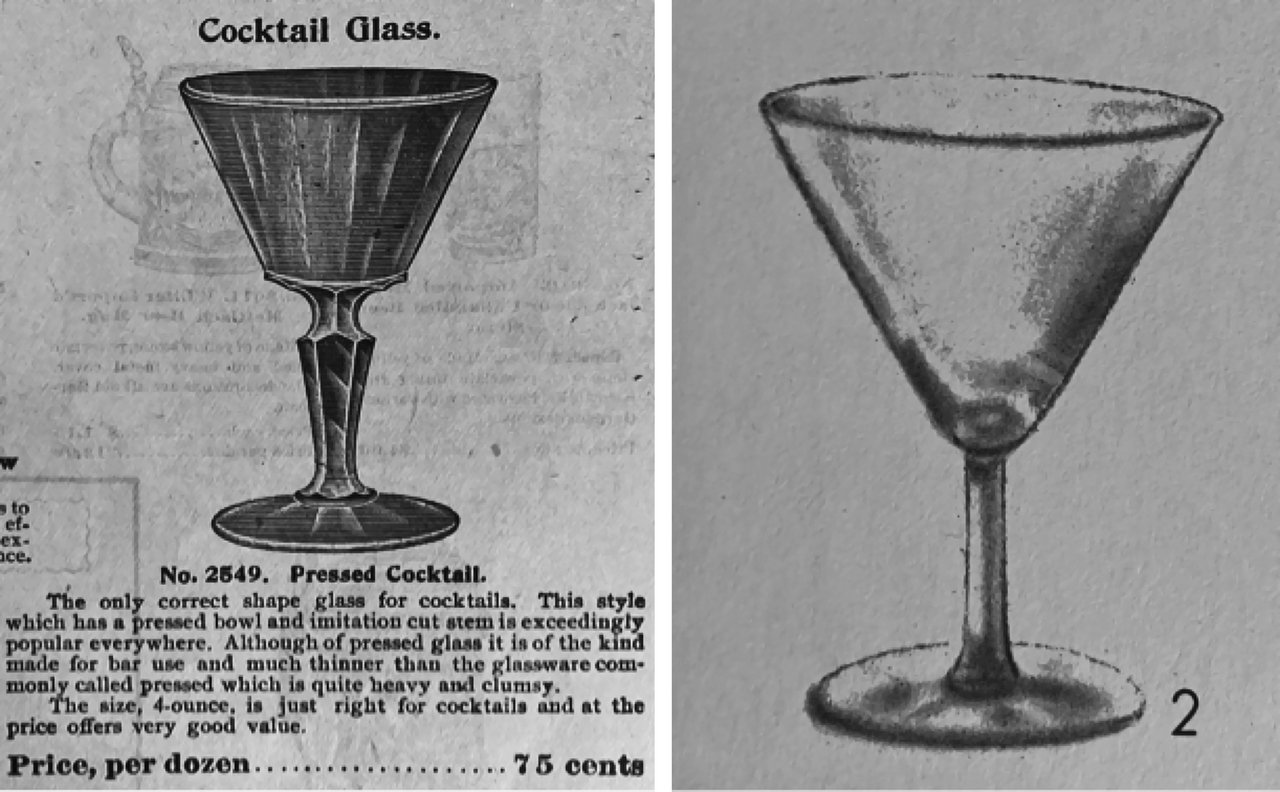glass, cocktail , also known as a “Martini glass,” is more than an item of glassware; it is a worldwide icon that wherever its image—the inverted right triangle, the slender stem, the halfhearted stabilizing base—is displayed proclaims “drinks served here.” Ironically, it was never intended as a cocktail glass at all.
In the early nineteenth century, when the cocktail was still “Cock-Tail,” a specific drink, not a broad class of them, it was served in the standard unstemmed, heavy-bottomed “small bar glass”—what we know today as an “Old-Fashioned glass.” See Cock-Tail and glassware. Small, stemmed glasses were known and used—and even small, stemmed conical glasses—but as wine glasses and dram glasses, not for American mixed drinks. See dram. But the original Cock-Tail was made either without ice or with a small lump or two in the glass. Once bartenders began stirring or tossing the drink with ice and then straining it, a stemmed glass was required so that the chilled drink would not be warmed by the heat of the drinker’s hand. See tossing. At first, as one finds in bartender’s guides from the 1860s, wine glasses were used, either plain or “fancy.” These usually had a rounded bowl, curving inwards at the top. By the early 1870s, however, one begins to see recipes calling specifically for a “cocktail glass,” and before long these begin to appear in glassware catalogues. The bowl is still rounded, but the glass has dispensed with the incurving rim (perhaps to make it easier to strain the cocktail into it from the height at which bartenders usually performed that action), but the sides are higher than those of a proper champagne coupe.
Haerdtl’s design was an immediate hit and was quickly imitated by other designers, many of them straightening out the slight flare and making it strictly geometrical. At first these glasses were indeed used for champagne, as one sees in several Hollywood movies from the late 1920s. By 1933, however, when America repealed Prohibition, the style was the last word in cocktail glasses. It did not hurt that its simplified outline made it a natural choice for portraying in neon.
The early cocktail glasses were very small, holding from 75 to 90 ml. Haerdtl’s design, although elegant, was quite prone to spillage if filled anywhere close to the rim, yet if the “wash line” was too low, customers would think they were being cheated. See tension line. That led to bigger glasses—which the customers then expected to be filled. By 1939 this vicious circle had led to the “double Martini glass,” which held from 180 to 240 ml. After the Second World War, the glass kept growing. By the 1970s, a double Martini glass might hold as much as 480 ml, a paralyzing amount of liquid given the ultradry Martinis of the day, or really any Martini, no matter how you mix it. With the cocktail renaissance of the twenty-first century, sanity reasserted itself and the standard size was closer to 150 ml. Indeed, the sanity even went beyond that, in resurrecting the use of parallel-sided or even incurved coupes and “Nick and Nora” glasses—just as elegant as Haerdtl’s design and far less likely to spill. See cocktail renaissance.
See also expositions and world’s fairs.
“American Fancy Drinks.” New York Sun, August 22, 1873, 3.
Fiederer, Luke. “AD Classics: Exposition Internationale des Arts Décoratifs et Industriels Modernes.” ArchDaily, August 19, 2016. www.archdaily.com/793367/ad-classics-exposition-internationale-des-arts-decoratifs-et-industriels-modernes (accessed April 11, 2021).
Wondrich, David. Imbibe!, 2nd ed. New York: Perigee, 2015.
By: David Wondrich
The typical cocktail glass, ca. 1910, left, and post-1930, right.
Wondrich Collection.
 The typical cocktail glass, ca. 1910, left, and post-1930, right. Source: Wondrich Collection.
The typical cocktail glass, ca. 1910, left, and post-1930, right. Source: Wondrich Collection.
